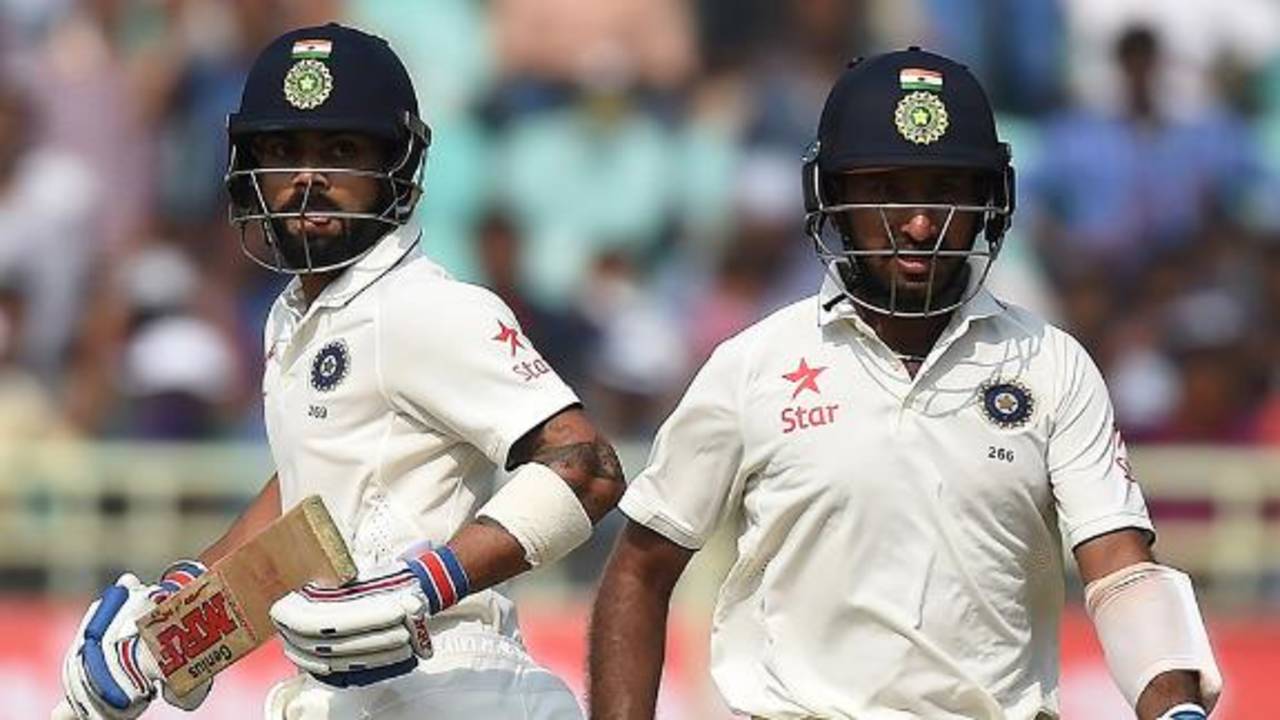Pujara, Kohli swap roles to dominate England
In a commanding stand of 226 runs, Virat Kohli appeared careful and solid like Cheteshwar Pujara, who was free-flowing and entertaining like Kohli
Alagappan Muthu in Visakhapatnam
17-Nov-2016
Virat Kohli cased the joint. The security was tight. Two slips, a short point, a short cover and a third man and sweeper on the boundary. Visakhapatnam was housing precious cargo. First-innings runs. The India captain was on a mission to steal them.
He had to be mindful of a few traps though. England's seamers were the first to highlight the weakness he has outside the off stump. While the pitch offered no sideways movement, which was often Kohli's undoing in 2014, since when is the tendency to drive away from the body predicated on the conditions?
In the morning, Stuart Broad filled an over with good-length balls on sixth or seventh stump. Kohli simply let them go. He was new to the crease. He could not afford to play those audacious shots through the covers. India were two down in the first half hour and there were men waiting for edges, both outside and leading. Once, when his patience flickered, he was beaten by a legcutter that bounced a lot more than it should have. England were setting up trip wires to catch a careless thief.
Kohli had to be cautious. To do what he loves - dominate - in a Test match, he had put in the work. Spend time in the middle. Get used to the pitch, get used to the bowling. Thereafter, he is a good enough player to come up with a counter. By shuffling across the off stump, he was able to reach for those full and wide deliveries without having to stretch out. This method works well provided there is no swing or seam. By the end of the day the cover drive was his most profitable shot.
Smuggling a total of 317 out is not a one-man job, though. Cheteshwar Pujara is not normally one to break the rules. Maybe that's why he looked like he was having so much fun. On 99, after rocking back to hit an Adil Rashid long hop high over midwicket, he admired the ball disappear into the crowd. And when it did, he turned around to the dressing room with the smile of a man who was starting to love his walk on the wild side. "Completing a hundred with a six was special."
Not to mention rare. Before this match, in 6134 balls faced, Pujara had sent only five over the fence. Why should he bother when he has such quick feet that he can turn decently-flighted deliveries from nervous spinners into full tosses and crunch them for four or slide back so deep in his crease that even a good length-ball is treated with almost the same merit as a long hop. He made 75 of his 119 runs at a strike-rate of almost 70 against the slow bowlers.

The last time India's Nos. 3 and 4 both scored centuries in the first innings of a Test was in 2007•Associated Press
And so a trend became apparent. For much of their 226-run partnership, Pujara was free-flowing and entertaining like Kohli. And Kohli was careful and solid like Pujara.
Pujara took on an 8-1 off-side field with a cut shot that was placed outstandingly well. It split point and cover and was too fine for the sweeper. Shots like that are his captain's trademarks. Having been asked to show more intent, Pujara showed plenty right in front of the man who had wanted him to do so.
Kohli, in turn, emulated his partner's prudence. He has an instinctive pull shot and it got him into trouble a couple of times - a top-edge off James Anderson flew a lot finer than intended and another off Ben Stokes could have ended his innings on 56, had the catch been taken, in the 43rd over. Recognising that he was not timing that shot as well as he normally does - like on a fast pitch where he might have the ball coming onto his bat - he stowed the shot away. Even his calm march through the nineties had shades of Pujara in it. Right down to a simple raise of the bat after he brought up his hundred.
But then, it came down in a twirl. In his 50th Test, as India's captain, Kohli knew his 151 not out had put his team on the path to a possible victory. Pujara's contribution - and evolution - cannot be underestimated either. With his 119, he now averages 66 in the first innings of Tests. No Indian - with a minimum cut-off of 20 innings - has done better.
Alagappan Muthu is a sub-editor at ESPNcricinfo
